The Testosterone Test Market is estimated to be valued at USD 114.3 million in 2025 and is projected to reach USD 222.7 million by 2035, registering a compound annual growth rate (CAGR) of 6.8% over the forecast period.
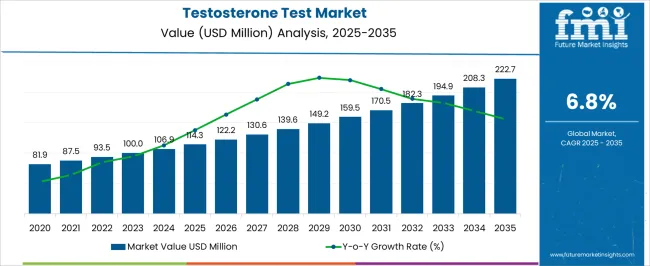
| Metric | Value |
|---|---|
| Testosterone Test Market Estimated Value in (2025 E) | USD 114.3 million |
| Testosterone Test Market Forecast Value in (2035 F) | USD 222.7 million |
| Forecast CAGR (2025 to 2035) | 6.8% |
The testosterone test market is expanding consistently, fueled by growing awareness of hormonal health, increasing prevalence of endocrine disorders, and rising healthcare investments in diagnostic testing. Demand is reinforced by aging demographics, greater emphasis on men’s health, and broader adoption of preventive healthcare practices.
Technological advancements in immunoassays and point-of-care testing have improved accessibility and diagnostic accuracy. The current market is characterized by rising screening rates in hospitals and clinics, supported by insurance coverage and government initiatives promoting early detection of hormonal imbalances.
Future growth is expected to be shaped by expanding applications of testosterone testing in fertility treatment, sports medicine, and personalized healthcare approaches. With healthcare providers prioritizing comprehensive diagnostic services, the market is poised for continued expansion.
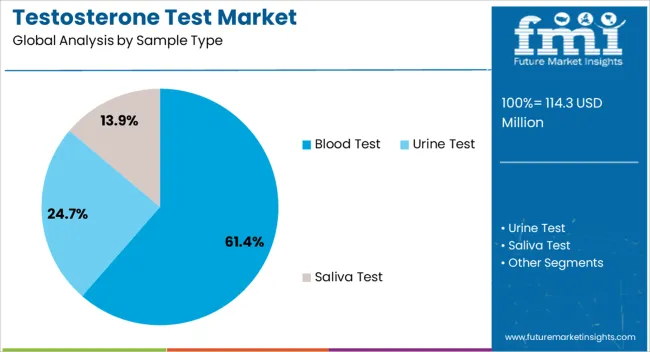
The blood test segment leads the sample type category with approximately 61.4% share, reflecting its position as the gold standard for testosterone measurement. High accuracy, widespread clinical acceptance, and ease of integration into existing laboratory workflows support its dominance.
Blood-based diagnostics provide reliable hormone level quantification, making them essential for detecting hypogonadism, infertility, and other endocrine disorders. Demand is further supported by growing healthcare infrastructure and routine screening programs.
With continued advancements in laboratory automation and immunoassay technologies, the blood test segment is expected to retain its leading role.
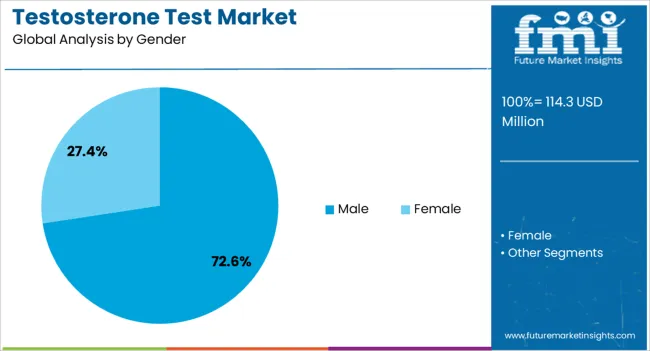
The male segment dominates the gender category with approximately 72.6% share, supported by the high prevalence of testosterone deficiency and related health concerns among men. Rising awareness of conditions such as low testosterone, erectile dysfunction, and age-related hormonal decline has fueled demand for diagnostic testing.
The segment also benefits from increased preventive screening and therapeutic interventions targeted at male health.
With growing acceptance of hormonal therapies and greater healthcare engagement, the male segment is expected to sustain its strong position.
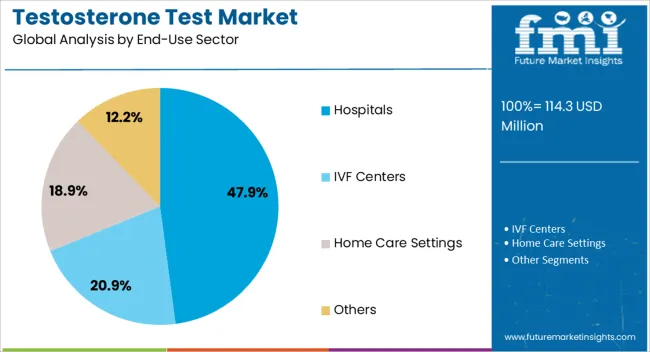
The hospitals segment holds approximately 47.9% share of the end-use sector, reflecting its central role in providing comprehensive diagnostic and treatment services. Hospitals offer advanced laboratory infrastructure and access to specialized endocrinologists, ensuring accurate and timely testosterone testing.
Increased patient footfall, integration of hormone tests into broader diagnostic panels, and insurance coverage reinforce this segment’s importance.
With expanding healthcare networks and rising investments in hospital-based diagnostic services, the hospitals segment is projected to maintain its leading share.
In 2025, the market for testosterone tests represented around 22.5% of the total global fertility testing market.
The market for testosterone tests has grown at a CAGR of 5.1% from 2020 to 2025, driven by an increase in demand due to rising rates of infertility, erectile dysfunction, testicular cancer, and delayed puberty.
| Historical Market Value, 2025 | USD 100.0 million |
|---|---|
| HCAGR, 2020 to 2035 | 5.1% |
The testosterone tests are performed using blood, saliva, and urine. The testing kits are not only used for testosterone but are now developed by combining several other hormone tests. Thus, advancements in the kit made it possible to diagnose the disease with one kit. Also, the results obtained are much easier to read and understand. The customization of the results based on age is also provided by the companies. The samples taken are pain-free and are easy to collect.
Few of the companies provide video instructions for every step to be performed, which make it easy for the patients to use and they are also provided with live support access. Also, the patients are provided with personalized medical advice with results.
The improper balance of testosterone levels in the body can lead to testicular cancer. Also in females, high levels of testosterone are proven to be the reason for developing conditions like polycystic ovarian syndrome (PCOS). The rising number of PCOS in females has also added to the growth of the testosterone test market.
Hence, owing to the factors mentioned above, the global testosterone test market is projected to grow at a CAGR of 6.9% from 2025 to 2035.
There is a growing awareness regarding the importance of testosterone levels in various health conditions, including hypogonadism, infertility, and sexual dysfunction. This awareness has led to an increased demand for testosterone testing, driving market growth.
Male infertility is a significant concern worldwide, and testosterone testing is an essential component of the diagnostic process. With the increasing prevalence of male infertility, the demand for testosterone tests is expected to rise, presenting growth prospects for the market. Also, several other factors like testicular cancer, delayed puberty, increasing infertility, and low testosterone levels are expected to drive the demand for testosterone test kits over the forecast period.
The testosterone test market has significant growth potential in emerging and developing economies. Factors such as increasing healthcare expenditure, improving healthcare infrastructure, and rising awareness about hormonal disorders contribute to the market's expansion in these regions.
The unawareness among the population regarding the availability of these test kits and also, the lack of knowledge about using the kits is a key factor that affects the growth of the market.
Testosterone tests can be expensive, especially when advanced technologies and specialized equipment are involved. The cost factor can limit access to testing for individuals with limited financial resources, impacting market growth. The cost of kits used for testosterone tests is comparatively higher than the laboratory testing. This makes it unconventional to use in developing and underdeveloped countries.
Testosterone tests are performed with blood or saliva. The tests using saliva as the sample in the test kit are still questioned regarding the accuracy of the results. The market's growth throughout the forecast period may be impacted by all of the above-mentioned variables.
| Countries | CAGR (2025 to 2035) |
|---|---|
| United States | 6.4% |
| Germany | 3.9% |
| India | 7.0% |
| United Kingdom | 6.7% |
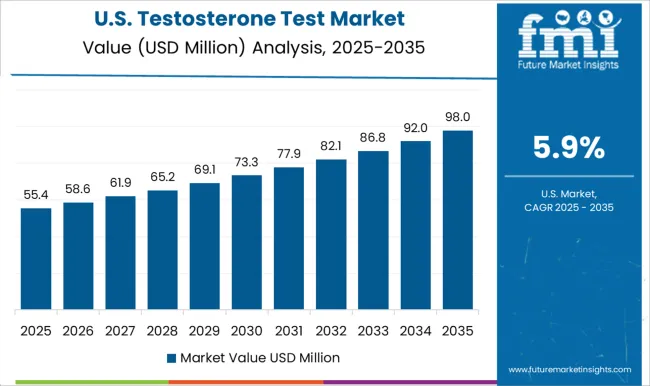
Accounting for a market share of 89.9%, the United States is leading the market in North America.
Infertility is a key concern and a common problem in males. Infertility in males is rising in the United States. Infertility issues in men are increasing this market in this region.
Testosterone imbalances, such as hypogonadism, are becoming more prevalent in the United States population. Factors such as sedentary lifestyles, obesity, stress, and aging contribute to the rising incidence of these conditions. The need for diagnosing and monitoring testosterone levels drives the demand for testosterone tests.
The Indian market for testosterone tests hold a share of 50.0% of the South Asian market.
Erectile dysfunction is a common complication observed in India. Erectile dysfunction is observed to be common among type 2 diabetes patients. Also, other factors are adding to the erectile dysfunction in males. Thus, it is expected to increase the market for testosterone tests.
The United Kingdom is expected to rise at a CAGR of 6.7% over the forecast period.
Low levels of testosterone cause testicular cancer, increasing the demand for testosterone testing in the country. Similar to other developed countries, the United Kingdom is witnessing a rise in the prevalence of testosterone-related disorders such as hypogonadism.
Lifestyle factors, the aging population, and other health conditions contribute to the increased incidence of testosterone imbalances. This drives the demand for testosterone tests for diagnosis and monitoring.
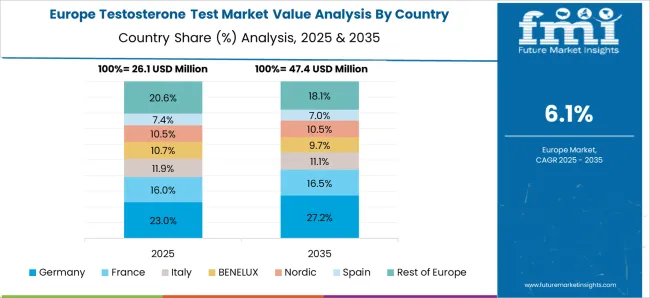
Germany held a significant share of 27.1% of the Europe testosterone test market.
The increasing healthcare expenditure and the rise in disposable income are the main reasons for boosting the market growth of testosterone tests in Germany. Other than this, the rise in awareness about the importance of testosterone for overall health and well-being is also fuelling market growth. This has led to an increased demand for testosterone tests among men of all age groups.
The blood sample for testosterone tests had a prominent market share of 45.2% in 2025. The segment is anticipated to grow at a CAGR of 7.0% during the forecast period.
| Top Sample Type | Blood Sample |
|---|---|
| Market Share in 2025 | 45.2% |
Blood samples are commonly used samples for testing any kind of hormone. The blood samples are considered to give accurate results as compared to any other samples. The reliability of the results makes it the most used and preferred sample for testosterone testing.
Males are the ones who are undergoing testosterone tests in a large number accounting for 84.5% market share.
| Top Gender | Males |
|---|---|
| Market Share in 2025 | 84.5% |
Testosterone plays an important role in males. The deficiency or rise in the levels of testosterone causes many problems in males which makes it necessary to have a record of the testosterone levels. As males are mostly affected by the levels of testosterone, therefore they hold a significant market share of this market.
| Top End-use Sector | Home Care Settings |
|---|---|
| Market Share in 2025 | 40.2% |
The home care settings segment accounted for a prominent market share of 40.2%.
The increasing availability of test kits for home care settings and the ease of collecting the sample also the easy availability of the results provided by the manufacturers is boosting the market for home care settings.
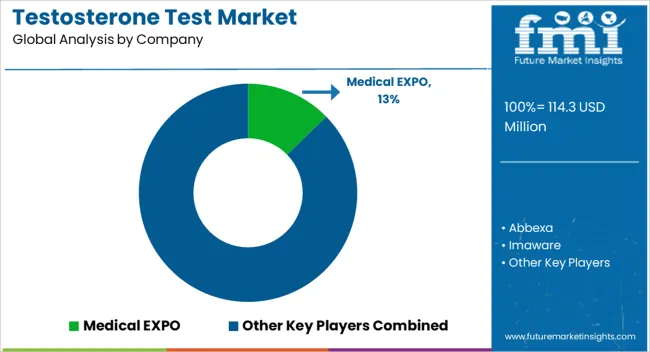
To gain a presence in the market, the leading testosterone test businesses are primarily focusing on increasing their market share and kit supply. Leading producers like LetsGetChecked and Everlywell employ tactical strategies like collaboration and expansion to increase the supply of testosterone test kits.
| Attribute | Details |
|---|---|
| Forecast Period | 2025 to 2035 |
| Historical Data Available for | 2020 to 2035 |
| Market Analysis | USD Million for Value |
| Key Regions Covered | North America; Latin America; Europe; South Asia; East Asia; Oceania; and Middle East & Africa (MEA) |
| Key Countries Covered | USA, Canada, Brazil, Mexico, Argentina, UK, Germany, Italy, Russia, Spain, France, BENELUX, India, Thailand, Indonesia, Malaysia, Japan, China, South Korea, Australia, New Zealand, Türkiye, GCC Countries, South Africa and North Africa |
| Key Market Segments Covered | Sample type, Gender, End User, and Region |
| Key Companies Profiled | Abbexa; Imaware; LetsGetChecked; Everlywell; Boditech; myLAB Box; Verisana; Cerascreen; MediChecks; Genway Biotech; Hone Health; Humankind Ventures Ltd.; Diagnostic Automation/Cortez Diagnostics Inc.; Myclinic.ie; Healthy Human Labs Ltd.; MyBioSource; Bluecrest Wellness; Testochecker |
| Pricing | Available upon Request |
The global testosterone test market is estimated to be valued at USD 114.3 million in 2025.
The market size for the testosterone test market is projected to reach USD 222.7 million by 2035.
The testosterone test market is expected to grow at a 6.8% CAGR between 2025 and 2035.
The key product types in testosterone test market are blood test, urine test and saliva test.
In terms of gender, male segment to command 72.6% share in the testosterone test market in 2025.






Full Research Suite comprises of:
Market outlook & trends analysis
Interviews & case studies
Strategic recommendations
Vendor profiles & capabilities analysis
5-year forecasts
8 regions and 60+ country-level data splits
Market segment data splits
12 months of continuous data updates
DELIVERED AS:
PDF EXCEL ONLINE
Testosterone Booster Industry Analysis by Component, Source, Distribution Channels and Regions 2025 to 2035
Testosterone Injectable Market
Test and Measurement Equipment Market Size and Share Forecast Outlook 2025 to 2035
Test rig Market Size and Share Forecast Outlook 2025 to 2035
Test and Measurement Sensors Market Size and Share Forecast Outlook 2025 to 2035
Testing, Inspection & Certification Market Growth – Trends & Forecast 2025 to 2035
Test Tube Market
Testliner Market
Testicular Cancer Treatment Market
Intestinal Health Pet Dietary Supplement Market Size and Share Forecast Outlook 2025 to 2035
Intestinal Pseudo-Obstruction Treatment Market - Trends, Growth & Forecast 2025 to 2035
Intestinal Fistula Treatment Market Growth - Demand & Innovations 2025 to 2035
5G Testing Market Size and Share Forecast Outlook 2025 to 2035
AB Testing Software Market Size and Share Forecast Outlook 2025 to 2035
RF Test Equipment Market Size and Share Forecast Outlook 2025 to 2035
5G Testing Equipment Market Analysis - Size, Growth, and Forecast 2025 to 2035
5G Tester Market Growth – Trends & Forecast 2019-2027
RF Tester Market Growth – Trends & Forecast 2019-2027
V2X Test Scenario Editor Market Size and Share Forecast Outlook 2025 to 2035
Eye Testing Equipment Market Size and Share Forecast Outlook 2025 to 2035

Thank you!
You will receive an email from our Business Development Manager. Please be sure to check your SPAM/JUNK folder too.
Chat With
MaRIA